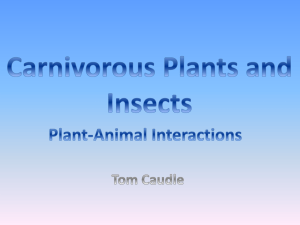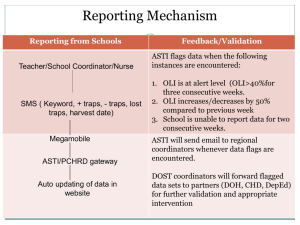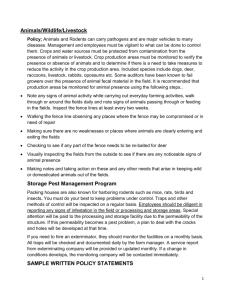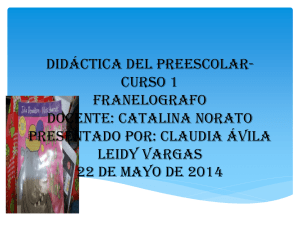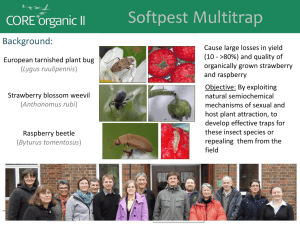Final Report - Rufford Foundation
advertisement
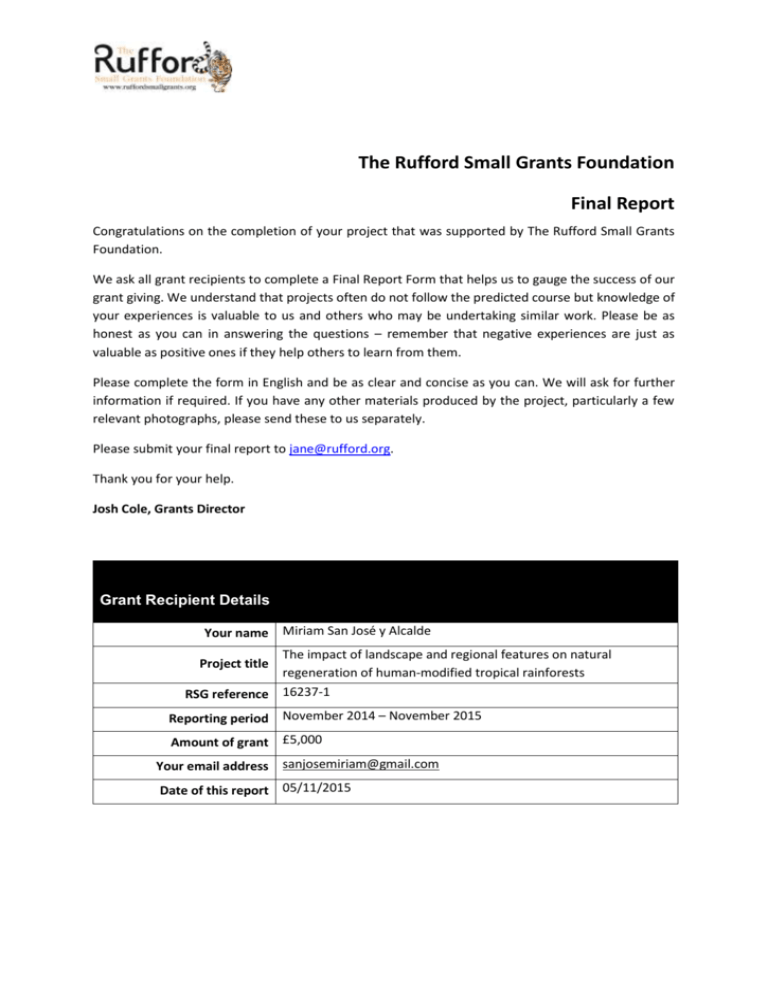
The Rufford Small Grants Foundation Final Report Congratulations on the completion of your project that was supported by The Rufford Small Grants Foundation. We ask all grant recipients to complete a Final Report Form that helps us to gauge the success of our grant giving. We understand that projects often do not follow the predicted course but knowledge of your experiences is valuable to us and others who may be undertaking similar work. Please be as honest as you can in answering the questions – remember that negative experiences are just as valuable as positive ones if they help others to learn from them. Please complete the form in English and be as clear and concise as you can. We will ask for further information if required. If you have any other materials produced by the project, particularly a few relevant photographs, please send these to us separately. Please submit your final report to jane@rufford.org. Thank you for your help. Josh Cole, Grants Director Grant Recipient Details Your name Miriam San José y Alcalde The impact of landscape and regional features on natural regeneration of human-modified tropical rainforests RSG reference 16237-1 Project title Reporting period November 2014 – November 2015 Amount of grant £5,000 Your email address sanjosemiriam@gmail.com Date of this report 05/11/2015 1. Please indicate the level of achievement of the project’s original objectives and include any relevant comments on factors affecting this. Objective Identify the landscape characteristics with higher impact on natural regeneration of forest fragments Test for differences among plant functional groups (seed size, light tolerance and dispersal syndrome) Share information and technical reports to NGOs and Mexican environmental agencies. Workshops with local communities Share the results in specialised journals and meetings. Hire and train local people. Not achieved Partially achieved X Fully achieved X Comments I have sampled the seed rain and saplings during 10 months (JanuaryFebruary 2015), so I have not done all fieldwork. Yet it will be finished in February 2016, and I will start the analyses on this objective in May 2016. The work is advancing very well, but a little bit slower that I though because I spend more days than expected at the beginning, when I was looking for permissions to landowners and local authorities. As stated above, I need to spend more time for the identification and classification of all plant species, but the study is advancing very well, and I have no doubt that I will do it. X Still in process. This objective will be achieved after achieving the previous two objectives. X This objective will be achieved after achieving the previous three objectives. I attend the RSG Conference and shared my project with other colleagues. Yet I expect I will publish my first paper on this project during the next year (2016). X X 2. Please explain any unforeseen difficulties that arose during the project and how these were tackled (if relevant). The main unforeseen difficulties were the robbery of traps, or some tricks made by young people. For example, one seed trap was burned by unknown local people in one site at Lacandona. In this case, we communicated the problem to the local authority, and the traps were never again touched. In the case of robberies, I talked to the landowners or people responsible for that site about what happened and asked for their help to look out the traps. I also put tags on the traps indicating that the traps belong to my Academic Institution (UNAM, Mexico) and that they are part of a student’s research project. We also asked different local people to please don’t touch the traps. 3. Briefly describe the three most important outcomes of your project. Until now, the most important outcome is to train local people in identifying the seeds and giving them a job so they can obtain incomes and learn about the regeneration of rainforests. Another important outcome is the progress in the fieldwork (i.e. I have completed >70% of the field work). I almost finished the seed rain survey and now I am identifying all seed species. 4. Briefly describe the involvement of local communities and how they have benefitted from the project (if relevant). Local communities have been involved since the beginning of the study. The field assistants have been benefited from this grant by the salary I paid them every month. They have built their houses and have money to send their kids to school. I also have two students from Balzapote (Los Tuxtlas rainforest, Veracruz, Mexico) that are helping me with the cleaning of seed traps and preparation of all samples for further identification in my lab. These students are also receiving an economical payment. 5. Are there any plans to continue this work? I plan to finish the fieldwork during the first months of 2016 and start all analyses approximately in Month YEAR. After this, I will prepare scientific papers and all materials to make two workshops in local communities (end of 2016). In the long term, I want to keep in contact with the reserve committee from Los Tuxtlas to design a landscape restoration plan based on the results of this project. 6. How do you plan to share the results of your work with others? I will participate in national and international conferences to share the results with colleagues. I will also make a simplified book of the final report to give it to landowners, Biological Field Station “Los Tuxtlas”, CONANP and some NGOs like “Natura Mexicana, A.C.”, “Fundación Selva (Chajul)”. 7. Timescale: Over what period was the RSG used? How does this compare to the anticipated or actual length of the project? The Rufford Foundation grant was used at the beginning of the project to buy all the materials, pay field assistants, talk to landowners for permissions and travels between Lacandona and Los Tuxtlas rainforests. The time that Rufford Grant was used compare to the total length of the project is about one third. This year the members of my lab and I received a grant from UNAM which was used to continue the fieldwork. 8. Budget: Please provide a breakdown of budgeted versus actual expenditure and the reasons for any differences. All figures should be in £ sterling, indicating the local exchange rate used. Item Budgeted Amount 815 1,080 Actual Amount 1,126 1,080 Difference Comments 311 0 More traps were needed. 837 1,984 1,147 Field station fees in Los Tuxtlas 2,268 1,944 -324 I hired in total five assistants, three more than expected. Part of this budget has been paid with the UNAM grant. Until now, I have used the money for 12 months instead of 14 months. TOTAL 5,000 6,134 1,134 Materials for seed traps Terrestrial transportations (Morelia - Chajul - Los Tuxtlas – Morelia) in one vehicle (360£ each) Payment for field assistants 9. Looking ahead, what do you feel are the important next steps? The next very important step to accomplish this project is finishing the field work and analysing data. Then, the most valuable and final step is to share the information with local communities and local authorities. 10. Did you use the RSGF logo in any materials produced in relation to this project? Did the RSGF receive any publicity during the course of your work? Yes, it is printed in the poster “Deforestation and Fragmentation” in the museum of Los Tuxtlas Biological Station. I did it for an event from Los Tuxtlas Biosphere Reserve (CONANP, SEMARNAT) within the “National Conservation Week”. It is also on the first slide of the presentation of my PhD Thesis advances. 11. Any other comments? I want to thank to Rufford for the grant obtained, without their support, this project would not be a reality.

